Impact of Recycled Aggregates on Civil Engineering Construction
VerifiedAdded on 2021/02/19
|20
|3895
|28
Project
AI Summary
This individual project delves into the application of recycled aggregates in civil engineering, focusing on the challenges and opportunities of replacing cement with recycled materials. The project begins with an introduction to the concept and identifies the problem of construction waste and the potential of recycled aggregates. Task 1 outlines the research methods, including questionnaires, experiments, focus groups, and surveys, with a preference for questionnaires. It also covers feasibility studies and a comparison of research strategies. Task 2 applies the CPM and PERT methods for project management, including data processing, critical path analysis, and time estimations. The project includes detailed tables and calculations for each method to determine the project schedule and critical activities. The conclusion summarizes the findings and the references provide sources for the project.
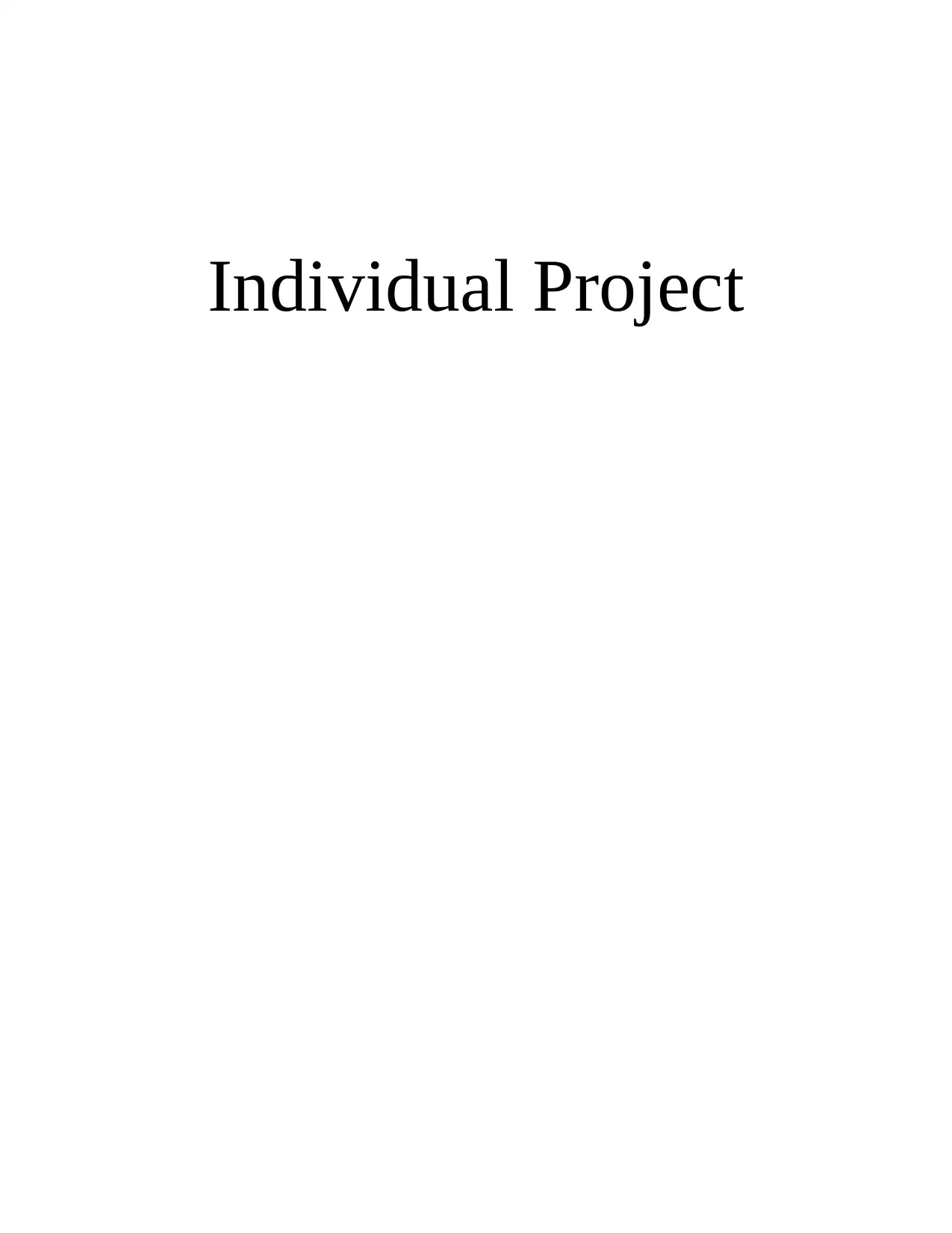
Individual Project
Paraphrase This Document
Need a fresh take? Get an instant paraphrase of this document with our AI Paraphraser
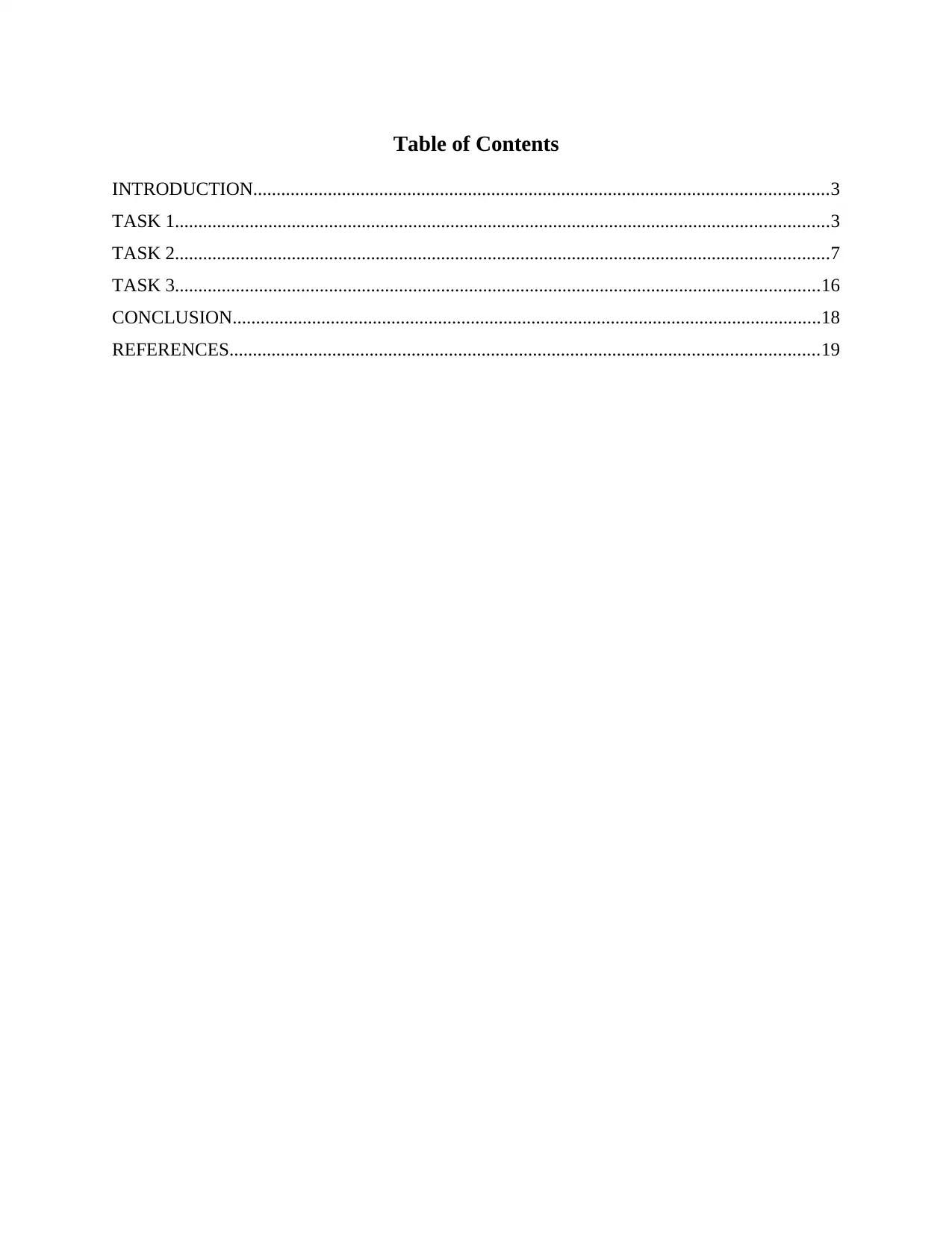
Table of Contents
INTRODUCTION...........................................................................................................................3
TASK 1............................................................................................................................................3
TASK 2............................................................................................................................................7
TASK 3..........................................................................................................................................16
CONCLUSION..............................................................................................................................18
REFERENCES..............................................................................................................................19
INTRODUCTION...........................................................................................................................3
TASK 1............................................................................................................................................3
TASK 2............................................................................................................................................7
TASK 3..........................................................................................................................................16
CONCLUSION..............................................................................................................................18
REFERENCES..............................................................................................................................19
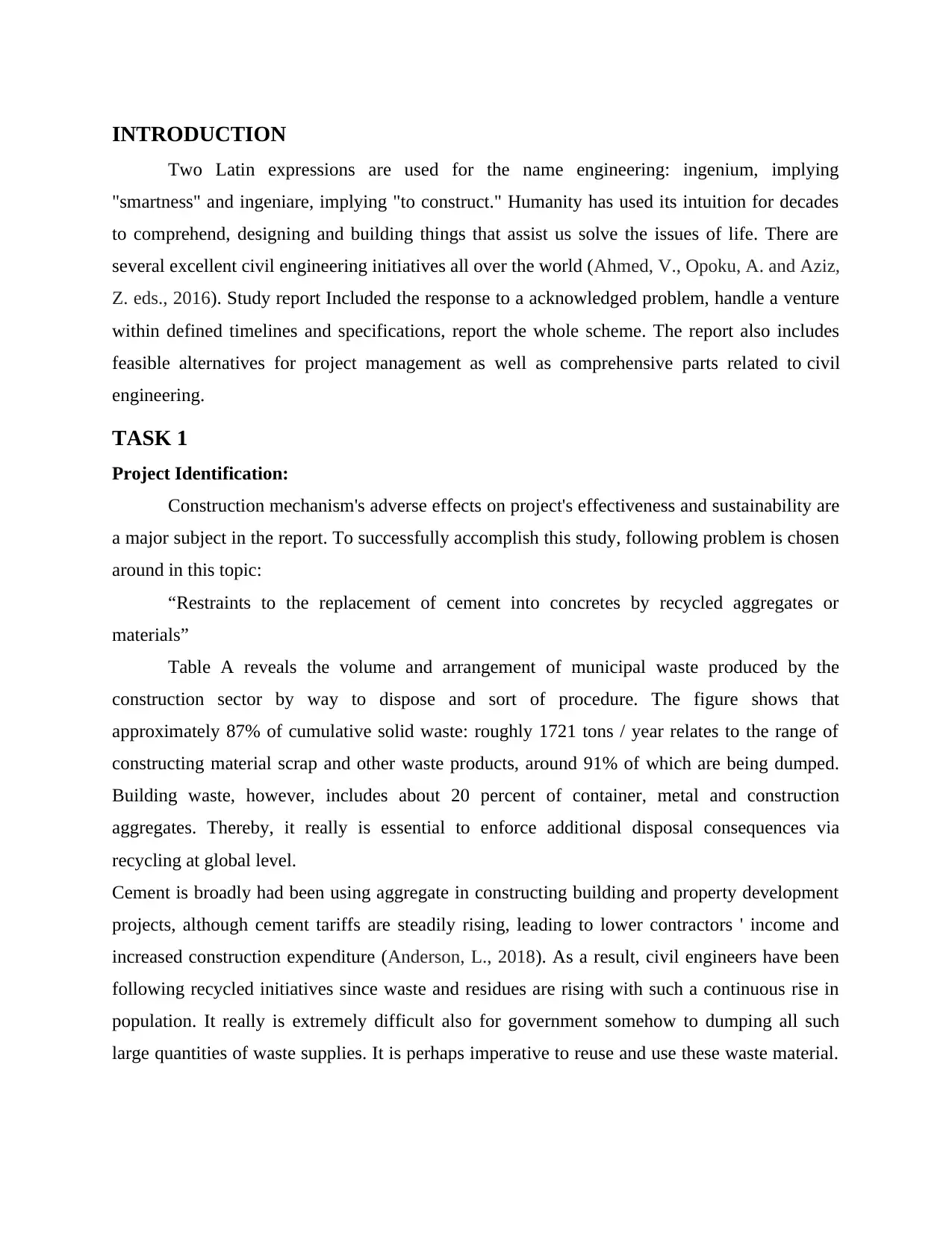
INTRODUCTION
Two Latin expressions are used for the name engineering: ingenium, implying
"smartness" and ingeniare, implying "to construct." Humanity has used its intuition for decades
to comprehend, designing and building things that assist us solve the issues of life. There are
several excellent civil engineering initiatives all over the world (Ahmed, V., Opoku, A. and Aziz,
Z. eds., 2016). Study report Included the response to a acknowledged problem, handle a venture
within defined timelines and specifications, report the whole scheme. The report also includes
feasible alternatives for project management as well as comprehensive parts related to civil
engineering.
TASK 1
Project Identification:
Construction mechanism's adverse effects on project's effectiveness and sustainability are
a major subject in the report. To successfully accomplish this study, following problem is chosen
around in this topic:
“Restraints to the replacement of cement into concretes by recycled aggregates or
materials”
Table A reveals the volume and arrangement of municipal waste produced by the
construction sector by way to dispose and sort of procedure. The figure shows that
approximately 87% of cumulative solid waste: roughly 1721 tons / year relates to the range of
constructing material scrap and other waste products, around 91% of which are being dumped.
Building waste, however, includes about 20 percent of container, metal and construction
aggregates. Thereby, it really is essential to enforce additional disposal consequences via
recycling at global level.
Cement is broadly had been using aggregate in constructing building and property development
projects, although cement tariffs are steadily rising, leading to lower contractors ' income and
increased construction expenditure (Anderson, L., 2018). As a result, civil engineers have been
following recycled initiatives since waste and residues are rising with such a continuous rise in
population. It really is extremely difficult also for government somehow to dumping all such
large quantities of waste supplies. It is perhaps imperative to reuse and use these waste material.
Two Latin expressions are used for the name engineering: ingenium, implying
"smartness" and ingeniare, implying "to construct." Humanity has used its intuition for decades
to comprehend, designing and building things that assist us solve the issues of life. There are
several excellent civil engineering initiatives all over the world (Ahmed, V., Opoku, A. and Aziz,
Z. eds., 2016). Study report Included the response to a acknowledged problem, handle a venture
within defined timelines and specifications, report the whole scheme. The report also includes
feasible alternatives for project management as well as comprehensive parts related to civil
engineering.
TASK 1
Project Identification:
Construction mechanism's adverse effects on project's effectiveness and sustainability are
a major subject in the report. To successfully accomplish this study, following problem is chosen
around in this topic:
“Restraints to the replacement of cement into concretes by recycled aggregates or
materials”
Table A reveals the volume and arrangement of municipal waste produced by the
construction sector by way to dispose and sort of procedure. The figure shows that
approximately 87% of cumulative solid waste: roughly 1721 tons / year relates to the range of
constructing material scrap and other waste products, around 91% of which are being dumped.
Building waste, however, includes about 20 percent of container, metal and construction
aggregates. Thereby, it really is essential to enforce additional disposal consequences via
recycling at global level.
Cement is broadly had been using aggregate in constructing building and property development
projects, although cement tariffs are steadily rising, leading to lower contractors ' income and
increased construction expenditure (Anderson, L., 2018). As a result, civil engineers have been
following recycled initiatives since waste and residues are rising with such a continuous rise in
population. It really is extremely difficult also for government somehow to dumping all such
large quantities of waste supplies. It is perhaps imperative to reuse and use these waste material.
⊘ This is a preview!⊘
Do you want full access?
Subscribe today to unlock all pages.

Trusted by 1+ million students worldwide

So here's a concern which contractors or developers are worried regarding recycling expenditures
and construct venture quality.
and construct venture quality.
Paraphrase This Document
Need a fresh take? Get an instant paraphrase of this document with our AI Paraphraser
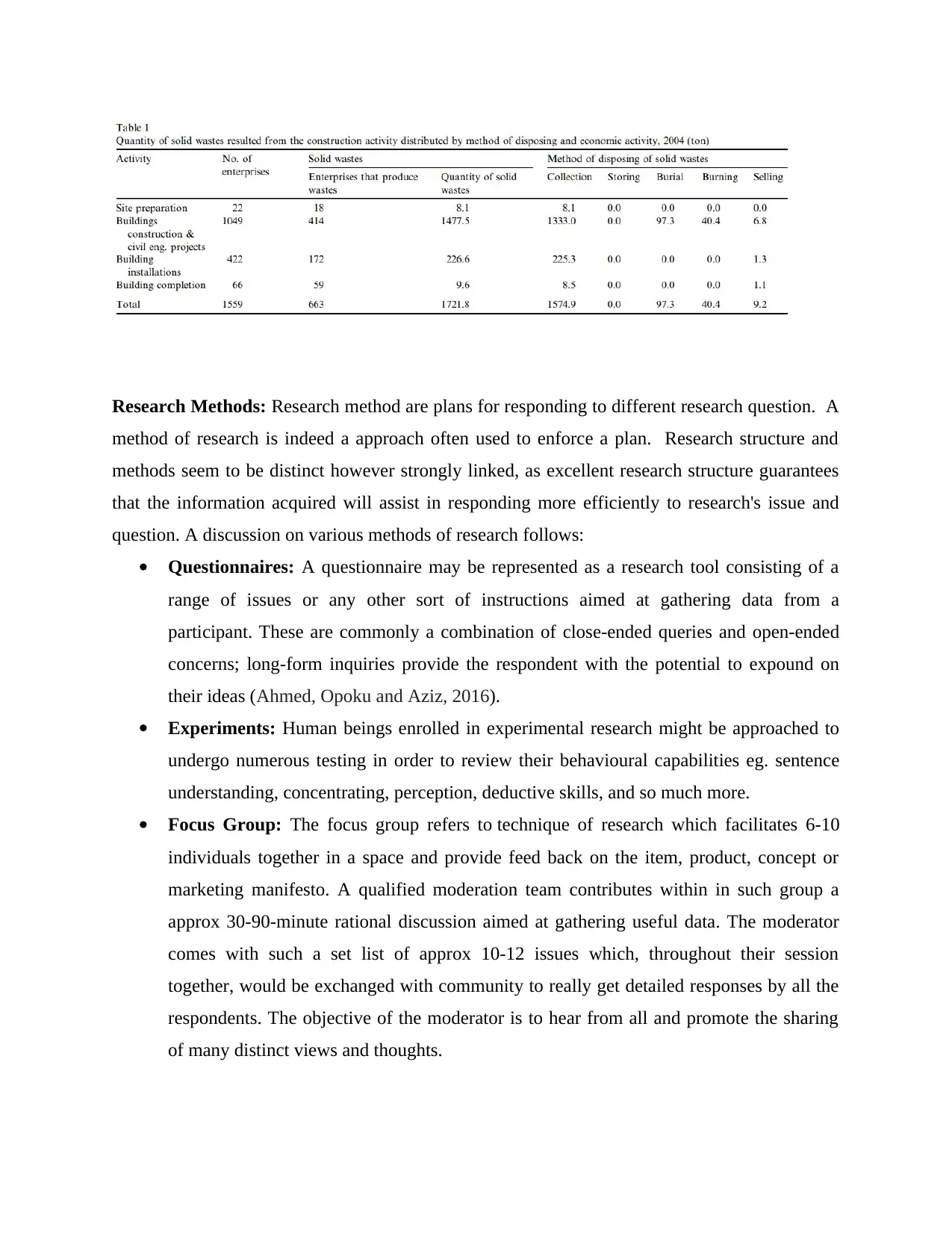
Research Methods: Research method are plans for responding to different research question. A
method of research is indeed a approach often used to enforce a plan. Research structure and
methods seem to be distinct however strongly linked, as excellent research structure guarantees
that the information acquired will assist in responding more efficiently to research's issue and
question. A discussion on various methods of research follows:
Questionnaires: A questionnaire may be represented as a research tool consisting of a
range of issues or any other sort of instructions aimed at gathering data from a
participant. These are commonly a combination of close-ended queries and open-ended
concerns; long-form inquiries provide the respondent with the potential to expound on
their ideas (Ahmed, Opoku and Aziz, 2016).
Experiments: Human beings enrolled in experimental research might be approached to
undergo numerous testing in order to review their behavioural capabilities eg. sentence
understanding, concentrating, perception, deductive skills, and so much more.
Focus Group: The focus group refers to technique of research which facilitates 6-10
individuals together in a space and provide feed back on the item, product, concept or
marketing manifesto. A qualified moderation team contributes within in such group a
approx 30-90-minute rational discussion aimed at gathering useful data. The moderator
comes with such a set list of approx 10-12 issues which, throughout their session
together, would be exchanged with community to really get detailed responses by all the
respondents. The objective of the moderator is to hear from all and promote the sharing
of many distinct views and thoughts.
method of research is indeed a approach often used to enforce a plan. Research structure and
methods seem to be distinct however strongly linked, as excellent research structure guarantees
that the information acquired will assist in responding more efficiently to research's issue and
question. A discussion on various methods of research follows:
Questionnaires: A questionnaire may be represented as a research tool consisting of a
range of issues or any other sort of instructions aimed at gathering data from a
participant. These are commonly a combination of close-ended queries and open-ended
concerns; long-form inquiries provide the respondent with the potential to expound on
their ideas (Ahmed, Opoku and Aziz, 2016).
Experiments: Human beings enrolled in experimental research might be approached to
undergo numerous testing in order to review their behavioural capabilities eg. sentence
understanding, concentrating, perception, deductive skills, and so much more.
Focus Group: The focus group refers to technique of research which facilitates 6-10
individuals together in a space and provide feed back on the item, product, concept or
marketing manifesto. A qualified moderation team contributes within in such group a
approx 30-90-minute rational discussion aimed at gathering useful data. The moderator
comes with such a set list of approx 10-12 issues which, throughout their session
together, would be exchanged with community to really get detailed responses by all the
respondents. The objective of the moderator is to hear from all and promote the sharing
of many distinct views and thoughts.
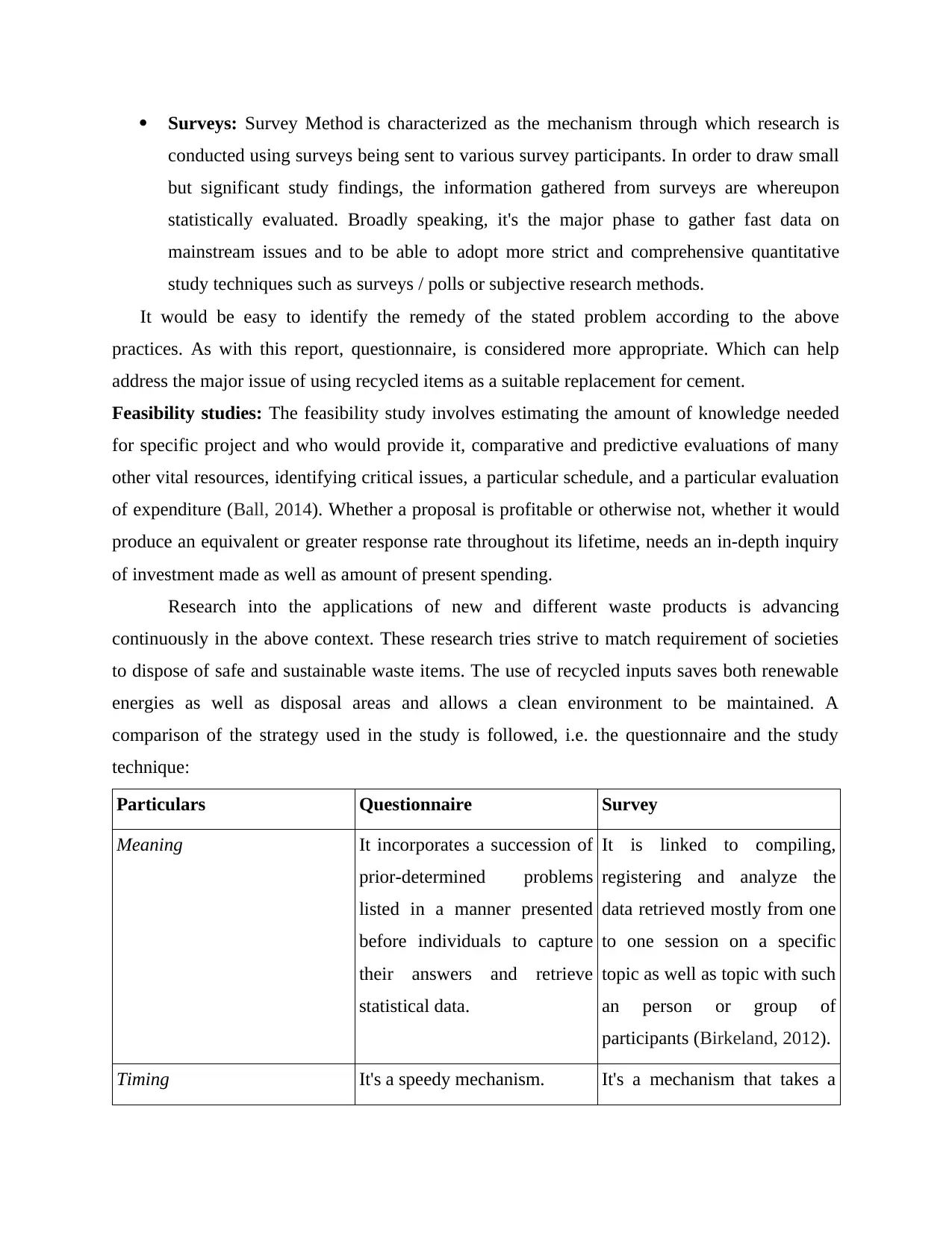
Surveys: Survey Method is characterized as the mechanism through which research is
conducted using surveys being sent to various survey participants. In order to draw small
but significant study findings, the information gathered from surveys are whereupon
statistically evaluated. Broadly speaking, it's the major phase to gather fast data on
mainstream issues and to be able to adopt more strict and comprehensive quantitative
study techniques such as surveys / polls or subjective research methods.
It would be easy to identify the remedy of the stated problem according to the above
practices. As with this report, questionnaire, is considered more appropriate. Which can help
address the major issue of using recycled items as a suitable replacement for cement.
Feasibility studies: The feasibility study involves estimating the amount of knowledge needed
for specific project and who would provide it, comparative and predictive evaluations of many
other vital resources, identifying critical issues, a particular schedule, and a particular evaluation
of expenditure (Ball, 2014). Whether a proposal is profitable or otherwise not, whether it would
produce an equivalent or greater response rate throughout its lifetime, needs an in-depth inquiry
of investment made as well as amount of present spending.
Research into the applications of new and different waste products is advancing
continuously in the above context. These research tries strive to match requirement of societies
to dispose of safe and sustainable waste items. The use of recycled inputs saves both renewable
energies as well as disposal areas and allows a clean environment to be maintained. A
comparison of the strategy used in the study is followed, i.e. the questionnaire and the study
technique:
Particulars Questionnaire Survey
Meaning It incorporates a succession of
prior-determined problems
listed in a manner presented
before individuals to capture
their answers and retrieve
statistical data.
It is linked to compiling,
registering and analyze the
data retrieved mostly from one
to one session on a specific
topic as well as topic with such
an person or group of
participants (Birkeland, 2012).
Timing It's a speedy mechanism. It's a mechanism that takes a
conducted using surveys being sent to various survey participants. In order to draw small
but significant study findings, the information gathered from surveys are whereupon
statistically evaluated. Broadly speaking, it's the major phase to gather fast data on
mainstream issues and to be able to adopt more strict and comprehensive quantitative
study techniques such as surveys / polls or subjective research methods.
It would be easy to identify the remedy of the stated problem according to the above
practices. As with this report, questionnaire, is considered more appropriate. Which can help
address the major issue of using recycled items as a suitable replacement for cement.
Feasibility studies: The feasibility study involves estimating the amount of knowledge needed
for specific project and who would provide it, comparative and predictive evaluations of many
other vital resources, identifying critical issues, a particular schedule, and a particular evaluation
of expenditure (Ball, 2014). Whether a proposal is profitable or otherwise not, whether it would
produce an equivalent or greater response rate throughout its lifetime, needs an in-depth inquiry
of investment made as well as amount of present spending.
Research into the applications of new and different waste products is advancing
continuously in the above context. These research tries strive to match requirement of societies
to dispose of safe and sustainable waste items. The use of recycled inputs saves both renewable
energies as well as disposal areas and allows a clean environment to be maintained. A
comparison of the strategy used in the study is followed, i.e. the questionnaire and the study
technique:
Particulars Questionnaire Survey
Meaning It incorporates a succession of
prior-determined problems
listed in a manner presented
before individuals to capture
their answers and retrieve
statistical data.
It is linked to compiling,
registering and analyze the
data retrieved mostly from one
to one session on a specific
topic as well as topic with such
an person or group of
participants (Birkeland, 2012).
Timing It's a speedy mechanism. It's a mechanism that takes a
⊘ This is a preview!⊘
Do you want full access?
Subscribe today to unlock all pages.

Trusted by 1+ million students worldwide

lot of time.
Application To weigh on their own
reactions, this is transmitted to
the targeted audience.
It is carried out onto the target
surveyed by the researcher.
Type of queries Contains mostly Close ended
like queries
Contains both Open/close
ended queries.
Features This is a procedure used to
retrieve information.
It is a productive mechanism
of information sharing and
evaluation.
Recommendation:
Owing to the fundamental precepts, the survey approach and questionnaire technique
resemble each other, but there is still a key distinction between them that makes researchers
follow each other as necessary. Questionnaire is indeed the technique whereby the researcher
supplies to the participants physical or digital forms that they are supposed to fill out according
to their own viewpoint. The researcher, however, registers answers in the survey methodology by
having to interact with attendees. A questionnaire technique is commonly favoured and more
trustworthy particularly in comparison to the study technique in the general practicability among
two (Cotgrave and Riley, 2012).The questionnaire approach delivers the individual or group's
immediate behavioural reactions, although the information may be somewhat distorted to
adverse in survey since often the candidates are not very interested in interacting, yet at the same
moment they can tap yes no effortlessly. Here, too, the behavioural consequences actually work,
the participants are somewhat completely irrational in survey approach because they do not
know precisely scope and scale of critical issues and the essential nature of whole research.
Even so, there is indeed a manual in list of questions that meets the users ' need to understand the
range of the analysis, thus helping them to form a stronger line between all the responses. The
questionnaire technique will thus take precedence between both the two despite restricting the
survey framework's importance.
Application To weigh on their own
reactions, this is transmitted to
the targeted audience.
It is carried out onto the target
surveyed by the researcher.
Type of queries Contains mostly Close ended
like queries
Contains both Open/close
ended queries.
Features This is a procedure used to
retrieve information.
It is a productive mechanism
of information sharing and
evaluation.
Recommendation:
Owing to the fundamental precepts, the survey approach and questionnaire technique
resemble each other, but there is still a key distinction between them that makes researchers
follow each other as necessary. Questionnaire is indeed the technique whereby the researcher
supplies to the participants physical or digital forms that they are supposed to fill out according
to their own viewpoint. The researcher, however, registers answers in the survey methodology by
having to interact with attendees. A questionnaire technique is commonly favoured and more
trustworthy particularly in comparison to the study technique in the general practicability among
two (Cotgrave and Riley, 2012).The questionnaire approach delivers the individual or group's
immediate behavioural reactions, although the information may be somewhat distorted to
adverse in survey since often the candidates are not very interested in interacting, yet at the same
moment they can tap yes no effortlessly. Here, too, the behavioural consequences actually work,
the participants are somewhat completely irrational in survey approach because they do not
know precisely scope and scale of critical issues and the essential nature of whole research.
Even so, there is indeed a manual in list of questions that meets the users ' need to understand the
range of the analysis, thus helping them to form a stronger line between all the responses. The
questionnaire technique will thus take precedence between both the two despite restricting the
survey framework's importance.
Paraphrase This Document
Need a fresh take? Get an instant paraphrase of this document with our AI Paraphraser

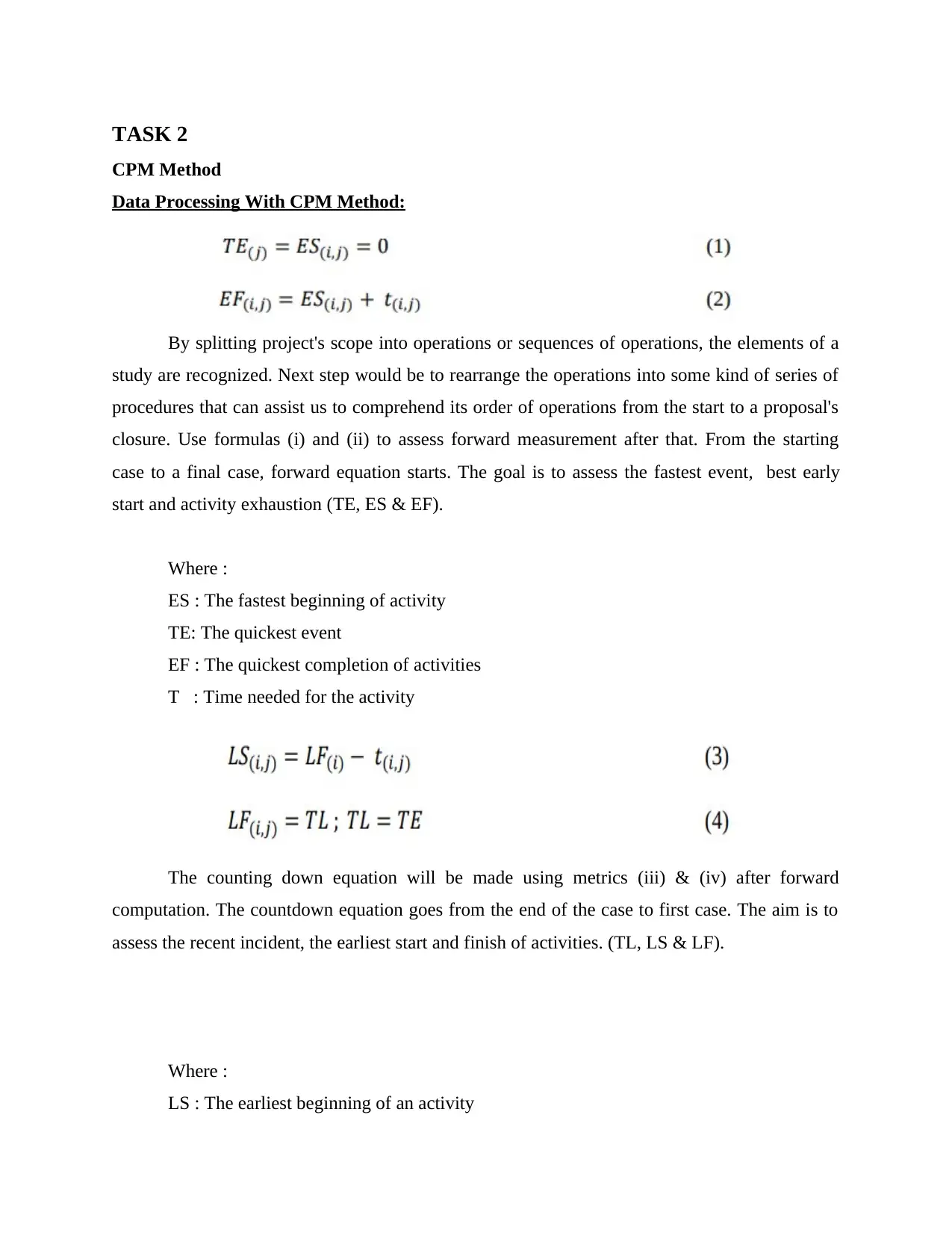
TASK 2
CPM Method
Data Processing With CPM Method:
By splitting project's scope into operations or sequences of operations, the elements of a
study are recognized. Next step would be to rearrange the operations into some kind of series of
procedures that can assist us to comprehend its order of operations from the start to a proposal's
closure. Use formulas (i) and (ii) to assess forward measurement after that. From the starting
case to a final case, forward equation starts. The goal is to assess the fastest event, best early
start and activity exhaustion (TE, ES & EF).
Where :
ES : The fastest beginning of activity
TE: The quickest event
EF : The quickest completion of activities
T : Time needed for the activity
The counting down equation will be made using metrics (iii) & (iv) after forward
computation. The countdown equation goes from the end of the case to first case. The aim is to
assess the recent incident, the earliest start and finish of activities. (TL, LS & LF).
Where :
LS : The earliest beginning of an activity
CPM Method
Data Processing With CPM Method:
By splitting project's scope into operations or sequences of operations, the elements of a
study are recognized. Next step would be to rearrange the operations into some kind of series of
procedures that can assist us to comprehend its order of operations from the start to a proposal's
closure. Use formulas (i) and (ii) to assess forward measurement after that. From the starting
case to a final case, forward equation starts. The goal is to assess the fastest event, best early
start and activity exhaustion (TE, ES & EF).
Where :
ES : The fastest beginning of activity
TE: The quickest event
EF : The quickest completion of activities
T : Time needed for the activity
The counting down equation will be made using metrics (iii) & (iv) after forward
computation. The countdown equation goes from the end of the case to first case. The aim is to
assess the recent incident, the earliest start and finish of activities. (TL, LS & LF).
Where :
LS : The earliest beginning of an activity
⊘ This is a preview!⊘
Do you want full access?
Subscribe today to unlock all pages.

Trusted by 1+ million students worldwide

LF : The earliest closure of an activity
TL : The earliest event
T : Time needed for an activity
To define the classpath, next step is to ascertain the free float and full float. Complete
float (v) is really the phase to interrupt the closing time for an case without influencing the
project's fastest closing time. The phase is the pivotal point that specifies the closing time of the
project (Naoum, 2012). Critical path does indeed have a cumulative float corresponding to null
while discovering the compiled code, then assess first the complete float for each work event.
Free float (vi) is the moment when it is possible to measure the accomplishment of an action
without interrupting the fastest time from the start of separate activity and the fastest occurrence
about something else on even a network.
Where :
TF : Total float
LF : The earliest beginning of an activity
ES : The quickest beginning of an activity
T : Time needed for an activity
Where :
FF : Free float
EF : The quickest completion of an activity
ES : The quickest beginning of an activity
T : Time needed for an activity
TL : The earliest event
T : Time needed for an activity
To define the classpath, next step is to ascertain the free float and full float. Complete
float (v) is really the phase to interrupt the closing time for an case without influencing the
project's fastest closing time. The phase is the pivotal point that specifies the closing time of the
project (Naoum, 2012). Critical path does indeed have a cumulative float corresponding to null
while discovering the compiled code, then assess first the complete float for each work event.
Free float (vi) is the moment when it is possible to measure the accomplishment of an action
without interrupting the fastest time from the start of separate activity and the fastest occurrence
about something else on even a network.
Where :
TF : Total float
LF : The earliest beginning of an activity
ES : The quickest beginning of an activity
T : Time needed for an activity
Where :
FF : Free float
EF : The quickest completion of an activity
ES : The quickest beginning of an activity
T : Time needed for an activity
Paraphrase This Document
Need a fresh take? Get an instant paraphrase of this document with our AI Paraphraser
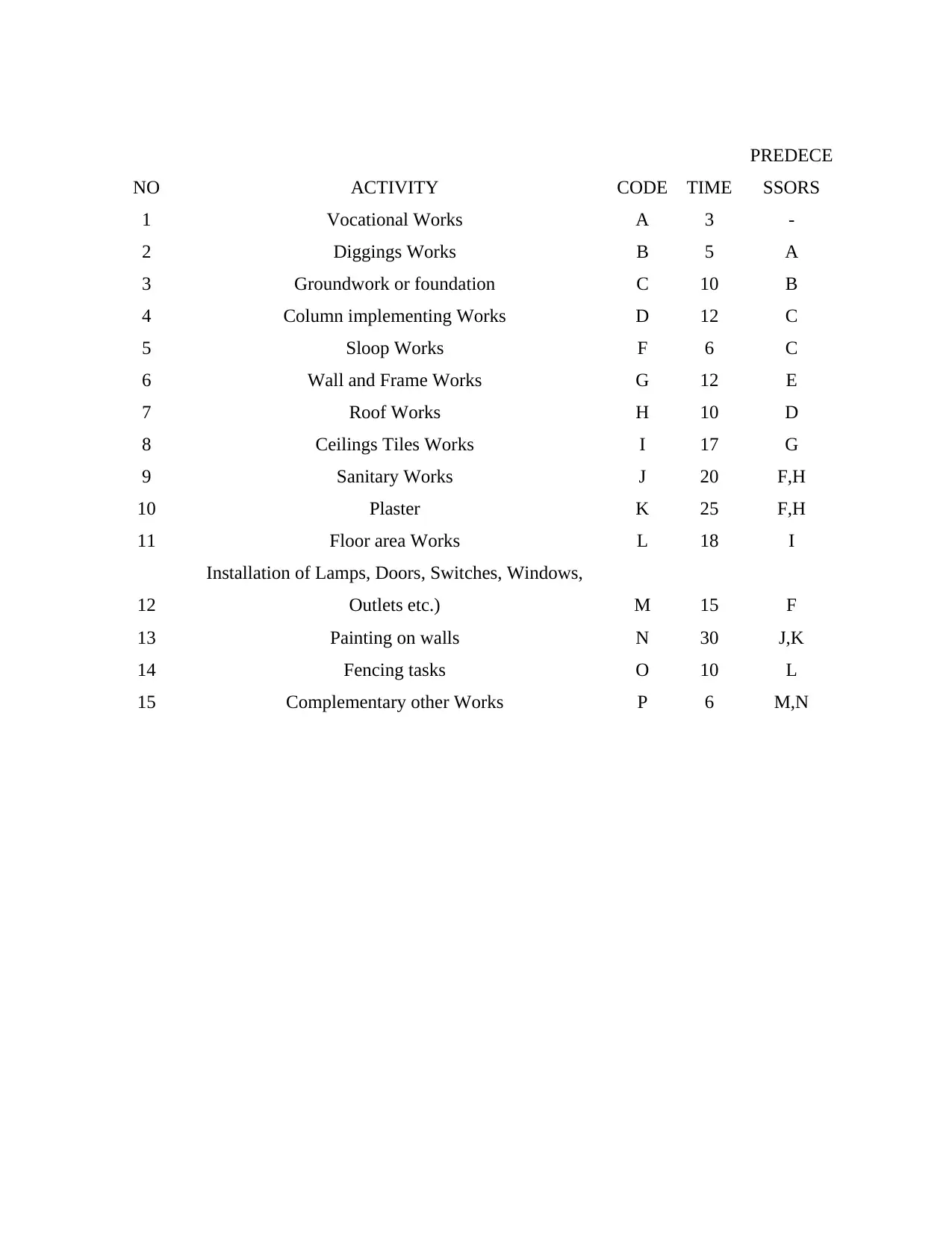
NO ACTIVITY CODE TIME
PREDECE
SSORS
1 Vocational Works A 3 -
2 Diggings Works B 5 A
3 Groundwork or foundation C 10 B
4 Column implementing Works D 12 C
5 Sloop Works F 6 C
6 Wall and Frame Works G 12 E
7 Roof Works H 10 D
8 Ceilings Tiles Works I 17 G
9 Sanitary Works J 20 F,H
10 Plaster K 25 F,H
11 Floor area Works L 18 I
12
Installation of Lamps, Doors, Switches, Windows,
Outlets etc.) M 15 F
13 Painting on walls N 30 J,K
14 Fencing tasks O 10 L
15 Complementary other Works P 6 M,N
PREDECE
SSORS
1 Vocational Works A 3 -
2 Diggings Works B 5 A
3 Groundwork or foundation C 10 B
4 Column implementing Works D 12 C
5 Sloop Works F 6 C
6 Wall and Frame Works G 12 E
7 Roof Works H 10 D
8 Ceilings Tiles Works I 17 G
9 Sanitary Works J 20 F,H
10 Plaster K 25 F,H
11 Floor area Works L 18 I
12
Installation of Lamps, Doors, Switches, Windows,
Outlets etc.) M 15 F
13 Painting on walls N 30 J,K
14 Fencing tasks O 10 L
15 Complementary other Works P 6 M,N
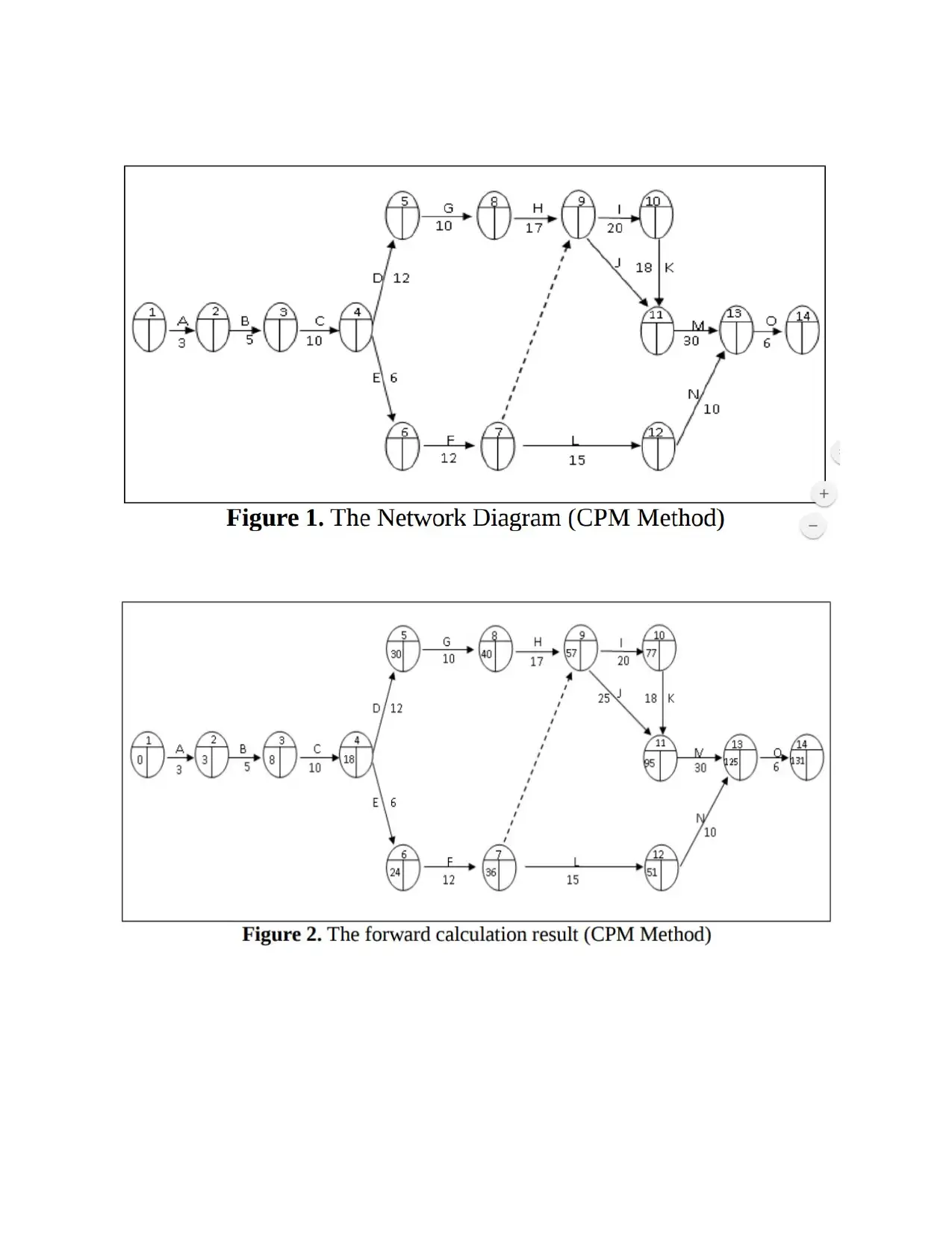
⊘ This is a preview!⊘
Do you want full access?
Subscribe today to unlock all pages.

Trusted by 1+ million students worldwide
1 out of 20
Related Documents
Your All-in-One AI-Powered Toolkit for Academic Success.
+13062052269
info@desklib.com
Available 24*7 on WhatsApp / Email
![[object Object]](/_next/static/media/star-bottom.7253800d.svg)
Unlock your academic potential
Copyright © 2020–2025 A2Z Services. All Rights Reserved. Developed and managed by ZUCOL.




